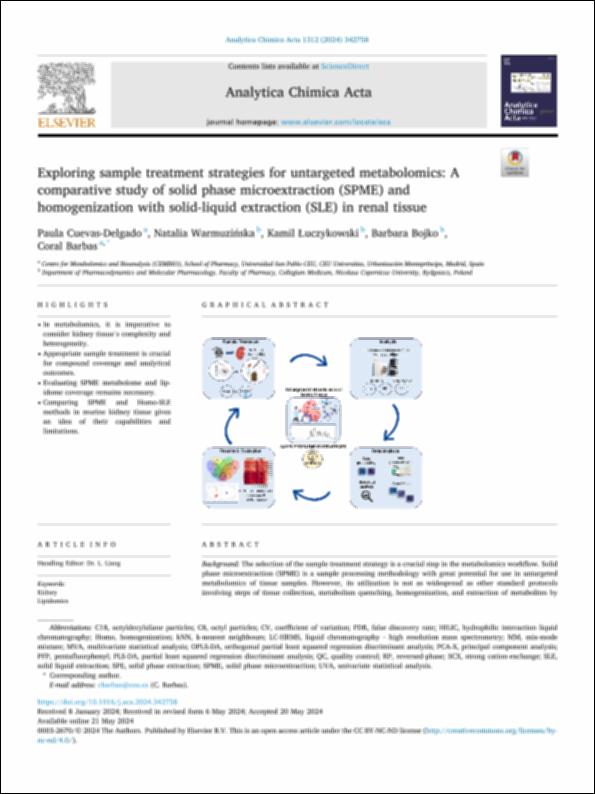Please use this identifier to cite or link to this item:
http://hdl.handle.net/10637/15855Exploring sample treatment strategies for untargeted metabolomics: A comparative study of solid phase microextraction (SPME) and homogenization with solid-liquid extraction (SLE) in renal tissue
| Title: | Exploring sample treatment strategies for untargeted metabolomics: A comparative study of solid phase microextraction (SPME) and homogenization with solid-liquid extraction (SLE) in renal tissue |
| Authors : | Cuevas Delgado, Paula Warmuzinska, Natalia Łuczykowski, Kamil Bojko, Barbara Barbas Arribas, Coral. |
| Keywords: | Lipidomics; Kidneys |
| Publisher: | Elsevier |
| Citation: | Paula Cuevas-Delgado, Natalia Warmuzińska, Kamil Łuczykowski, Barbara Bojko, Coral Barbas, Exploring sample treatment strategies for untargeted metabolomics: A comparative study of solid phase microextraction (SPME) and homogenization with solid-liquid extraction (SLE) in renal tissue, Analytica Chimica Acta, Volume 1312, 2024, 342758, ISSN 0003-2670, https://doi.org/10.1016/j.aca.2024.342758 |
| Abstract: | Background: The selection of the sample treatment strategy is a crucial step in the metabolomics workflow. Solid phase microextraction (SPME) is a sample processing methodology with great potential for use in untargeted metabolomics of tissue samples. However, its utilization is not as widespread as other standard protocols involving steps of tissue collection, metabolism quenching, homogenization, and extraction of metabolites by solvents. Since SPME allows us to perform all these steps in one action in tissue samples, in addition to other advantages, it is necessary to know whether this methodology produces similar or comparable metabolome and lipidome coverage and performance to classical methods. Results: SPME and homogenization with solid-liquid extraction (Homo-SLE) sample treatment methods were applied to healthy murine kidney tissue, followed by comprehensive metabolomics and lipidomics analyses. In addition, it has been tested whether freezing and storage of the tissue causes alterations in the renal metabolome and lipidome, so the analyses were performed on fresh and frozen tissue samples Lipidomics analysis revealed the exclusive presence of different structural membrane and intracellular lipids in the Homo-SLE group. Conversely, all annotated metabolites were detected in both groups. Notably, the freezing of the sample mainly causes a decrease in the levels of most lipid species and an increase in metabolites such as amino acids, purines, and pyrimidines. These alterations are principally detected in a statistically significant way by SPME methodology. Finally, the samples of both methodologies show a positive correlation in all the analyses. Significance: These results demonstrate that in SPME processing, as long as the fundamentals of non-exhaustive extraction in a pre-equilibrium kinetic regime, extraction in a tissue localized area, the chemistry of the fiber coating and non-homogenization of the tissue are taken into account, is an excellent method to use in kidney tissue metabolomics; since this methodology presents an easy-to-use, efficient, and less invasive approach that simplifies the different sample processing steps. |
| URI: | http://hdl.handle.net/10637/15855 |
| Rights : | http://creativecommons.org/licenses/by-nc-nd/4.0/deed.es Open Access |
| ISSN: | 1873-4324 |
| Supported by: | Acuerdo Transformativo - 2024 |
| Issue Date: | 21-May-2024 |
| Center : | Universidad San Pablo-CEU |
| Appears in Collections: | Facultad de Farmacia |
Items in DSpace are protected by copyright, with all rights reserved, unless otherwise indicated.


